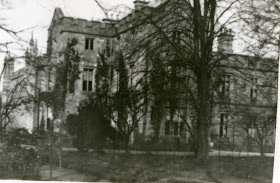A set of 20 photographs, mainly from 1904, the Anderson Family Photographs
refer to Alexander Anderson and his family, and show life in Galway University
at a time of transition both for the family themselves and society as a whole.
Anderson was the first person to suggest the existence of black holes and
the first to speculate about what would happen if a star collapsed under its
own gravity. He was a great man, whose ideas were ahead of his
time. Anderson was a teacher and researcher in Experimental and
Mathematical Physics as well as being an able University Administrator.
He devoted much of his life to University College Galway.
Originally from Coleraine, Anderson began his career at Queen’s College Galway
in 1877. He graduated in 1880 with a gold medal for his BA. He then
took first place in an open scholarship to Sydney Sussex College in the
University of Cambridge where he studied Physics and Mathematics and came out
as sixth wrangler in 1884. He returned to Galway in 1885 and shortly
after, succeeded Joseph Larmor as Professor of Natural Philosophy. He was
also president of Queen’s College Galway for thirty-five years.
Anderson’s interest in the practical applications of physics is illustrated by
the fact that his department was providing a medical radiography service in
Galway from 1898. He was also involved in industrially sponsored
research. Around 1899 the Eastman-Kodak Company provided a fellowship for
the study of X-ray photography. Unfortunately the tissue of a child was
damaged and scarred by an X-ray exposure. This activity attracted
worldwide attention, as it was the cause of probably the first instance of
litigation on the injurious effects of ionising radiation though the verdict
was in favour of the College. (Details of the case are available from one
of our small collections, P61, at http://archives.library.nuigalway.ie/col_level.php?col=P61
).
During his career in Galway, Anderson ensured that the Physics department
had state of the art equipment including the then newly invented X-ray and
radio apparatus and cathode ray tubes. It is said of Anderson that his
primary interest lay in teaching and that he was rarely content to give a piece
of theory from a textbook without first improving or simplifying it.
He married Emily, daughter of William J. Binns of the National Bank in Galway; they had a son and three daughters. Mrs Anderson was active in reform organisations and, with her daughters, attended local suffrage meetings; they were founder members of the Connaught Women's Franchise League in Galway in January 1913. Their daughter Emily was educated privately before entering QCG in 1908; she won a literary scholarship after an exceptional performance in her first-year examinations, when she placed first in English, French, German and Latin; in 1909 and 1910 she held the college's Browne scholarship, and in 1911 graduated BA. She specialised in German, and undertook postgraduate work at the universities of Berlin and Marburg. She was professor of German in UCG from 1917 till her resignation in 1920, when she moved to the Foreign Office in London. She was awarded an OBE for intelligence work in the Middle East, and translated and published The letters of Mozart and his family (1938) and The letters of Beethoven (1961). With her mother she was a founding member of the Connaught Women's Franchise League.
Their only son, also Alexander, enlisted in the 4th
Connaught Rangers Battalion as a lieutenant, and was attached to the Royal
Flying Corps. He was reported missing on 23 November 1916 and ended up as a
Prisoner of War. He was awarded a B. Sc. (Honoris Causa) in 1917 and later
appears on the Army List for the Connaught Rangers from 1918-1920.
The photographs are part of the research material
gathering by the late Dr. Tom O’Connor, Department of Physics, for work he did
on a history of that department. They give us a fascinating glimpse into the
lives of the Anderson family who grew up on the grounds of University College
Galway.






His son Alexander Anderson was my grandfather he later changed his name to Alexander Andrews after marrying a Dublin jewess Lillian Redman. His son my father Arthur Henry Andrews was an applied physicist who committed suicide in 1973.
ReplyDeleteI only now of one of the daughter Emily who wrote about Beethoven.
Regards
Stephen Daemon Andrews